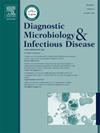Prediction of treatment success in patients with Enterococcus faecium bacteremia using vancomycin AUC24/MIC ratio: A multicenter retrospective study
IF 2.1
4区 医学
Q3 INFECTIOUS DISEASES
Diagnostic microbiology and infectious disease
Pub Date : 2025-06-18
DOI:10.1016/j.diagmicrobio.2025.116961
引用次数: 0
Abstract
Background
Although vancomycin is commonly used to treat Enterococcus faecium infections, there are no clear guidelines for the optimal 24-h area under the concentration time curve to minimum inhibitory concentration (AUC24/MIC) ratio. This study aimed to determine the target AUC24/MIC ratio associated with vancomycin-treated E. faecium infection outcomes.
Methods
This retrospective multicenter cohort study included adult patients who received vancomycin for ≥5 days for E. faecium-associated bloodstream infections between January 2018 and December 2023. The primary outcome was treatment success, defined as a composite of survival beyond 30 days, clinical success, and microbiological eradication. Secondary outcomes included 30-day mortality, clinical success, microbiological eradication, and nephrotoxicity. Receiver operating characteristic (ROC) curve analysis identified the AUC24/MIC cut-off value for treatment success. Multivariate regression analysis was used to determine the association between AUC24/MIC and outcomes.
Results
This study included 81 patients. ROC analysis identified AUC24/MIC ≥427 as the cutoff value for treatment success. The overall treatment success rate (71.6 %) was significantly higher in the above AUC24/MIC cut-off group (81.8 %) than in the below AUC24/MIC cut-off group (59.5 %). On multivariate analysis, AUC24/MIC ≥427 was an independent predictor (adjusted odds ratio: 4.399, 95 % confidence interval: 1.203–19.320, p = 0.024) of treatment success. The clinical success and microbiological eradication rates differed significantly between the below- and above-cut-off groups, whereas nephrotoxicity rates were comparable between the groups.
Conclusions
In treating E. faecium infections, vancomycin AUC24/MIC ratio ≥427 was independently associated with treatment success. However, further prospective studies are required to confirm the AUC24/MIC target.
使用万古霉素AUC24/MIC比值预测粪肠球菌菌血症患者治疗成功:一项多中心回顾性研究
虽然万古霉素常用来治疗屎肠球菌感染,但浓度时间曲线下的最佳24h面积与最低抑制浓度(AUC24/MIC)之比尚无明确的指导方针。本研究旨在确定与万古霉素治疗的粪肠杆菌感染结果相关的目标AUC24/MIC比率。方法本回顾性多中心队列研究纳入了2018年1月至2023年12月期间接受万古霉素治疗≥5天的粪肠杆菌相关血流感染的成年患者。主要结局是治疗成功,定义为超过30天的生存、临床成功和微生物根除的综合结果。次要结局包括30天死亡率、临床成功、微生物根除和肾毒性。受试者工作特征(ROC)曲线分析确定了治疗成功的AUC24/MIC临界值。采用多因素回归分析确定AUC24/MIC与预后的关系。结果本研究纳入81例患者。ROC分析确定AUC24/MIC≥427为治疗成功的临界值。总体治疗成功率(71.6%),高于AUC24/MIC临界值组(81.8%),明显高于低于AUC24/MIC临界值组(59.5%)。在多因素分析中,AUC24/MIC≥427是治疗成功的独立预测因子(校正优势比:4.399,95%可信区间:1.203-19.320,p = 0.024)。临床成功率和微生物根除率在低于临界值组和高于临界值组之间存在显著差异,而肾毒性率在两组之间具有可比性。结论万古霉素AUC24/MIC比值≥427与治疗成功独立相关。然而,需要进一步的前瞻性研究来确认AUC24/MIC靶点。
本文章由计算机程序翻译,如有差异,请以英文原文为准。
求助全文
约1分钟内获得全文
求助全文
来源期刊
CiteScore
5.30
自引率
3.40%
发文量
149
审稿时长
56 days
期刊介绍:
Diagnostic Microbiology and Infectious Disease keeps you informed of the latest developments in clinical microbiology and the diagnosis and treatment of infectious diseases. Packed with rigorously peer-reviewed articles and studies in bacteriology, immunology, immunoserology, infectious diseases, mycology, parasitology, and virology, the journal examines new procedures, unusual cases, controversial issues, and important new literature. Diagnostic Microbiology and Infectious Disease distinguished independent editorial board, consisting of experts from many medical specialties, ensures you extensive and authoritative coverage.

 求助内容:
求助内容: 应助结果提醒方式:
应助结果提醒方式:


